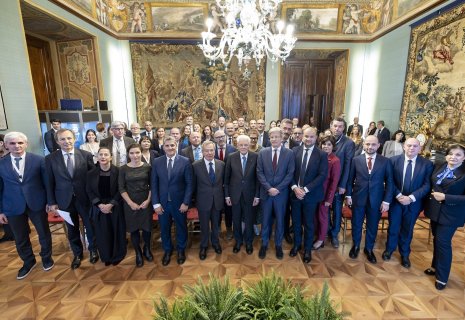
Strmol Castle - where fiction meets history
Slovenia is dotted with castles or fortresses, some of them well-preserved, others neglected or in ruins. Among the most famous is Strmol Castle, located some 25 kilometres north of Ljubljana. Visitors can learn about its storied past, including a tragic WWII chapter that inspired an acclaimed Slovenian novel, CE Report quotes The Slovenia Times.
Strmol is one of the country's oldest preserved castles, having been built in the Middle Ages, although the first traces of similar constructions elsewhere date as far back as antiquity. Same as dozens of other Slovenian castles it is now actively used for various purposes such as housing a hotel and museum and hosting high-level political meetings.
One of Europe's most unique castles
The castle is famous for its mystical surroundings, impressive furnishings and the story of its last private owners.
Named after its first owners, the Strmol knights, it is first mentioned in official records in the 13th century, and it is one of the few in the country to have kept a Slovenian name throughout its history.
A part of the Strmol family later moved east to Rogatec, where there is another beautifully preserved building bearing their name - Strmol Mansion.
Strmol Castle is perched on gently sloping ground, with its backside facing a forest-covered hill and its front providing a view of a landscaped parkland. A small lake in front of it completes the fairy tale-like picture.
The castle was declared a cultural monument of national importance in 2004, and in 2010-2012 it underwent a complete renovation in a bid to preserve this site of cultural significance.
In 2018, it received the Unique Castle of the Year award, presented by the London tourism magazine Travel and Hospitality, due to its impressive state of preservation.
Not far away, some 10 kilometres west, there is another famous destination, Brdo Castle, the country's main venue for hosting premier political events. Strmol Castle can be used for such occasions as well, but mere mortals may also spend the night there. Moreover, it is a popular location for weddings and known for its historical tours.
The tragic story of the castle's last private owners
At the heart of those tours is the famous story of the castle's last private owners, the Hribar couple, who were part of Slovenia's pre-WWII social elite, and their tragic fate.
A cosmopolitan industrialist and one of the richest Slovenians in the era between the two World Wars, Rado Hribar purchased the castle and its estate in 1936. He and his wife, Ksenija Hribar, were both members of prominent families and no strangers to mingling with aristocrats. Rado was close to Prince Paul of Yugoslavia, prince regent, who is believed to have bought the nearby Brdo Castle at his suggestion.
Before the start of the Second World War, Ksenija joined Rado at Strmol Castle, having ended an affair with a Serbian army officer with whom she had run away. The Hribar couple renewed their wedding vows at the castle, with those present later recounting an anecdote of them being tied together with a chain during the ceremony.
Patrons of the arts, the Hribars turned the castle into a lively meeting place not only for local and foreign members of the upper crust but also for artists and intellectuals. Over the years they built up a rich collection of artworks and other objects of exceptional value that are still on display today, as Strmol Castle is one of the few castles in Slovenia featuring most of its pre-WWII furnishings.
Famous for her unusual habits such as keeping a small crocodile as a pet, Ksenija was living proof that wealth and eccentricity often go hand in hand. She would put the 1.5-metre crocodile on a leash and walk it in Ljubljana's Tivoli Park. The exotic animal met its fate and was euthanised after it bit her husband while sharing a bath with him. The taxidermied crocodile is now on display in the castle, greeting visitors not far away from the entrance.
Another thing the couple had in common was their love for automobiles and aeroplanes. Rado was the first local owner of a private plane, and together with his brothers he planned to open a factory producing small aircraft. On top of being a skilled horsewoman, his wife was one of the first women pilots in the Kingdom of Yugoslavia.
During WWII, Rado maintained ties with the Germans to protect his family and business, which according to art historian Nika Leben involved hosting social gatherings where the Nazis were among the guests, but he also helped the resistance fighters, the Partisans. His help, which included securing a printing press for them, was not enough to prevent what followed.
In January 1944, a group of members of the secret Communist intelligence and security organisation VOS arrived at the castle to accuse them of treason. VOS was tasked with eliminating opponents of the Partisan movement, and it later transpired that its summary killings included innocent victims. That was also the case with the Hribars, who were declared guilty without proof or trial.
They were taken away by force, tortured and murdered, with their remains found in a forest roughly 10 kilometres away as late as 2015. There were some reports that the movement's upper echelons were against killing them, but the order to keep them safe and sound came in too late. The execution and the atrocities that preceded it seemed personal and were likely spurred on by the perpetrators' rage against the rich. Ksenija was 38 and Rado was 42 at the time of their death.
The couple's relatives succeeded with their bid to rehabilitate them in 2000, and there is a plaque at the castle paying tribute to Ksenija and Rado. It was unveiled at a ceremony in 2015 during which the then President Borut Pahor regretted the crimes against them and apologised for the time it had taken to restore their honour and dignity.
Impressive Baroque pieces and national treasure painting
After WWII, the castle was under state ownership - it was one of the many summer residencies of the former Communist regime. As part of denationalisation efforts in the wake of Slovenia's independence it was returned to its rightful owners, the relatives, who in 2004 agreed in a €5 million compensation deal that the state should keep it to ensure the appropriate upkeep of the building.
Ever since, the castle has been under heritage protection. Rado Hribar recreated the Baroque style of the building, having purchased many pieces from monasteries, antique shops and bankrupt noble families, while the oldest surviving part of the building dates back to the Renaissance.
A tabernacle cabinet from the former Adergas monastery, located not far away from the castle, is considered the most valuable piece in the castle. Another cherished possession is the famous oil painting Woman Drinking Coffee, whose replica adorns one of the rooms. A work of Slovenia's most prominent female painter Ivana Kobilca (1861-1926), the original, now owned by Rado's nephew Peter Hribar, is part of the permanent collection of the country's National Gallery.
Kobilca and Božidar Jakac (1899-1989), another Slovenian artistic maestro, were two of the artists Rado supported. A connoisseur of the Dutch art, he bought several replicas of the old masters, including Rembrandt, that were painted at roughly the same time as the originals.
Visitors may admire them during guided tours, which never fail to mention the art inspired by Rado and Ksenija's story - I Saw Her That Night, a celebrated novel by one of Slovenia's leading authors Drago Jančar, and the eponymous theatre production based on the book.
The novel filled in the gaps of history with fiction, while acknowledging that some things will never be known or understood fully. An impressive testament to resilience, the castle, although merely a building, seems to be aware of that, guarding its heritage as well as secrets.

























